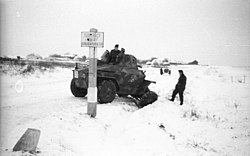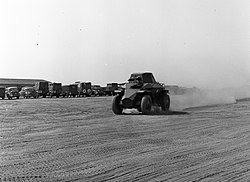39M Csaba
The 39M Csaba (t͡ʃɒbɒ) was a Hungarian armoured car designed by Nicholas Straussler. It was produced for the Royal Hungarian Army during World War II and used extensively on the Eastern Front fighting against the Soviet Union.
Development and Use

Hungarian expatriate Nicholas Straussler designed several armoured cars for Britain while living there between the two world wars. Straussler came to an agreement with the Weiss Manfred factory of Csepel, Budapest to produce vehicles from his designs for use in his home country – the most prominent was the Csaba (named after the son of Attila the Hun) which was designed based on his experience of the Alvis AC2 armoured car.[2]
After successful trials in 1939, the Hungarian Army placed an order for 61, and a further order for an additional 40 vehicles was placed in 1940. Of these, twenty were used as actual fighting vehicles, with the remainder serving as armoured command cars and reconnaissance vehicles.
In 1943 two cars, numbered RR511 & RR512, were painted blue for use by police units.[3]
The Csaba had a 20 mm Solothurn anti-tank cannon[4] and a coaxial 8 mm Gebauer 1934/37M machine gun fixed on a centrally mounted turret, with 9 mm armoured plating. The 20 mm cannon had 200 shells in 5 shell capacity magazines, for a total of 40 magazines, meanwhile the coaxial 8 mm Gebauer machine gun had 3000 rounds in 100 round metal belts.[5] The vehicle was also equipped with a detachable 8 mm Solothurn light machine gun fired through the rear hatch in the anti-aircraft role. The crew could dismount and carry this LMG when conducting reconnaissance on foot. It also had two driving positions – one at the front as normal, and an additional one at the rear.
The 40M Csaba was a command version armed only with the turret-mounted 8 mm machine gun. This vehicle was fitted with a second R-4T radio, which had a large lattice radio mast.[2]
The first Reconnaissance Battalion of Budapest's vehicles were marked with a lightning flash, as well as the Magyar Cross. The Magyar Cross was also seen on vehicles in Transylvania in September 1940, as well as in Yugoslavia and Russia in 1941. John Baumann speculates that the red and green cross may have served as an aiming point so it was later changed to a white cross on a grey/black background. Before October–November 1944, no German markings were found on 39Ms.[3]
The first 61 vehicles were assigned to the 1st Mechanized Brigade, the 2nd Mechanized Brigade, 1st Armored Division, 2nd Armored Division, and 1st Mountain Brigade. Three 39Ms served with the 1st Mountain Brigade, while the other units received ten 39Ms, one 40M, and two vehicles used for training. All except the 1st Mountain Brigade served in Operation Barbarossa. Combat use showed that the 39M should not be used outside of its reconnaissance role, with only 17 units having survived from those sent to the front by December 1941. The 1st Cavalry brigade lost 18 39Ms in December 1942. 48 combat-ready vehicles were available by the summer of 1944, which were assigned to four Hungarian infantry divisions, which fought in Galicia along with cavalry divisions. The number of 39Ms gradually decreased further and further starting in Autumn of 1944.[2]
Gallery
-
 Front view of a 39M Csaba
Front view of a 39M Csaba -
 Side view of a 39M Csaba
Side view of a 39M Csaba -
 39M Csaba armoured cars in 1940
39M Csaba armoured cars in 1940 -
 Interior of a 39M Csaba showing the coaxial Gebauer machine gun
Interior of a 39M Csaba showing the coaxial Gebauer machine gun -
 Interior of a 39M Csaba from the driver's position
Interior of a 39M Csaba from the driver's position -
 A 39M Csaba damaged by a landmine and with the turret covered in Serbia, 1941, during the Invasion of Yugoslavia
A 39M Csaba damaged by a landmine and with the turret covered in Serbia, 1941, during the Invasion of Yugoslavia -
 A 39M Csaba stuck in a ditch, 1940
A 39M Csaba stuck in a ditch, 1940 -
 A 39M Csaba driving at speed, 1943
A 39M Csaba driving at speed, 1943
References
Notes
- ^ Poór, István (1980). Harckocsik és páncélozott járművek típuskönyve. Budapest, HU: Zrínyi Kiadó. p. 154. ISBN 963-326-283-6.
- ^ a b c bocquelet, david. "39M/40M Czaba armoured car". tank-afv.com.
- ^ a b Baumann, John (January 1992). "Hungarian Armored Cars" (PDF). Armored Car - The wheeled Fighting Vehicle Journal (9). Retrieved 27 August 2024.
- ^ Zaloga, Steven J. (2018). The Anti-Tank Rifle. Oxford, UK: Osprey Publishing. p. 22. ISBN 978-1-4728-1722-8.
- ^ Jacky 95 (12 April 2018). "Csaba armored cars". Hungarianmilitaryww2. Retrieved 8 February 2023.
{{cite web}}: CS1 maint: numeric names: authors list (link)
Bibliography
- J C M Probst. "Hungarian armour during WW2". Airfix Magazine (September 1976).
External links

- "Hungarian Tanks". Archived from the original on 24 August 2007. Retrieved 2 August 2007.
- "Hungarian Army in Russia". Archived from the original on 30 March 2005. Retrieved 2 August 2007.
- "WW2 in Color". Archived from the original on 30 September 2007. Retrieved 2 August 2007.
- v
- t
- e
- 35M Tankette
- Toldi tanks
- Turán I and II
- 43M Turán III
- Panzer 35(t)
- Panzer 38(t)
- Panzer III
- Panzer IV
- Panzer V Panther
- Tiger I
- Hotchkiss H35
- SOMUA S35
- 39M Csaba
- Light Tank V4
- 44M Tas
- Toldi Páncélvadász
- Nimród 80mm


















